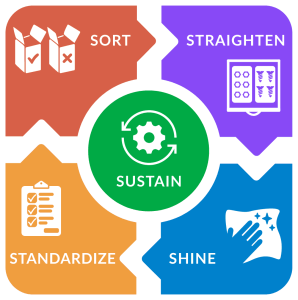4 Lean Manufacturing
This topic may seem like a tangent from the course goals of learning how to safely use equipment and tools in the lab. But, there is a connection. Fabrication of prostheses and orthoses includes multiple steps, such as, ordering/managing supplies, multiple people using equipment in an efficient and safe way, and managing paperwork. Dave Hughes, CPO and his employees at Cornerstone have organized their clinical and laboratory practices with the Lean Six Sigma methods. They have hosted multiple workshops to teach this process to P&O clinics around the world. They have demonstrated, that by reducing waste, prosthetists and orthotists can improve our workflow, improve workplace safety, and improve quality in the devices and services we provide.

What is lean manufacturing? Lean manufacturing focuses on increasing efficiencies by decreasing waste.
- Materials waste
- Use less material to get same product, re-use materials if possible
- Time waste
- Planning ahead when possible
- Energy waste
- Human
- Decrease movements by setting up and maintaining work space
- Machine
- Use machines properly and and correct times to decrease on time or reduce number of macines needed
- Human
- Money waste
- Inefficiencies = Wasted Money
Why do we want to use lean manufacturing principles in P&O?
- Efficient for cost control and profitability in times of decreased reimbursement
- Decrease injuries
- Long term (e.g., Overuse injury)
- Short term (e.g., Accidents)
- Reducing waste is better for the environment
